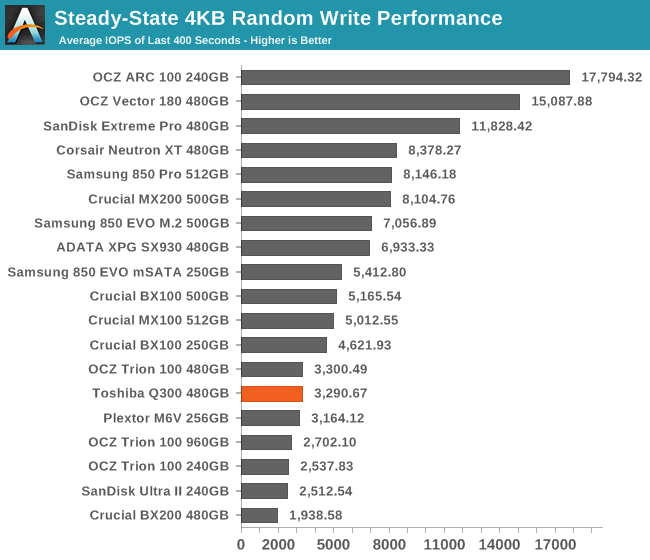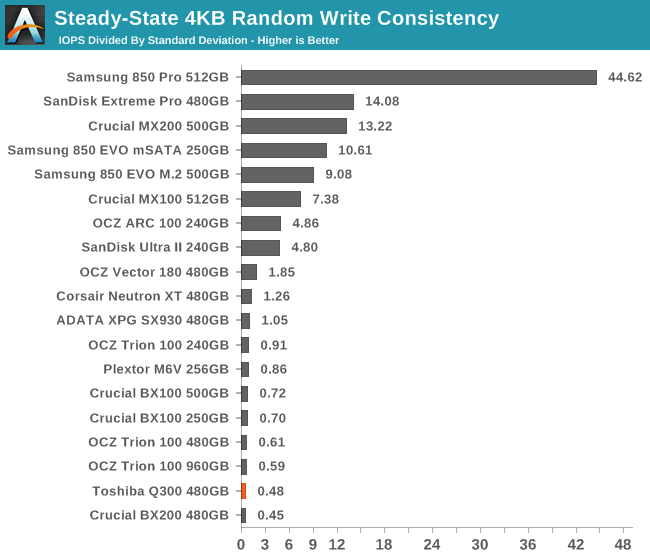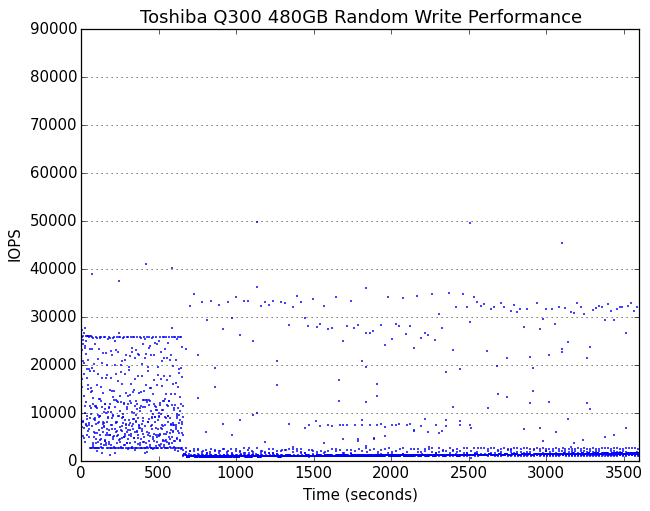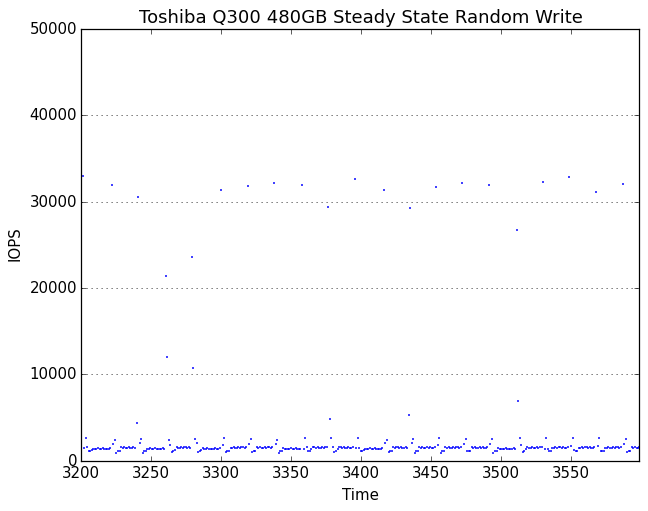The Toshiba Q300 SSD Review: Toshiba Becomes a Retail Brand
by Billy Tallis on February 26, 2016 8:00 AM ESTPerformance Consistency
Before we start things off, I would like to cover a quick housekeeping note. Over the winter I've made some changes to the SSD testbed and our benchmarking procedures, with the goal of streamlining the process as much as possible while still producing results that are directly comparable with our 2015 benchmark scores. Performance testing is conducted with drives in a hot-swap bay so that they can be pulled from the testbed to be securely erased and pre-filled by a separate computer. I still have to manually move the drives around between phases of our benchmark suite, but the entire process of running the tests and parsing the results to generate graphs for the review is now automated and much less error prone. The new process also keeps more of the raw data around, so in future reviews I may experiment with new ways to graph what we're measuring. The Toshiba Q300's close similarity to the OCZ Trion 100 has helped validate the new procedures.
With that out of the way, we start things off with our performance consistency test, which explores the extent to which a drive can reliably sustain performance during a long-duration random write test. Specifications for consumer drives typically list peak performance numbers only attainable in ideal conditions. The performance in a worst-case scenario can be drastically different as over the course of a long test drives can run out of spare area, have to start performing garbage collection, and sometimes even reach power or thermal limits.
In addition to an overall decline in performance, a long test can show patterns in how performance varies on shorter timescales. Some drives will exhibit very little variance in performance from second to second, while others will show massive drops in performance during each garbage collection cycle but otherwise maintain good performance, and others show constantly wide variance. If a drive periodically slows to hard drive levels of performance, it may feel slow to use even if its overall average performance is very high.
To maximally stress the drive's controller and force it to perform garbage collection and wear leveling, this test conducts 4kB random writes with a queue depth of 32. The drive is filled before the start of the test, and the test duration is one hour. Any spare area will be exhausted early in the test and by the end of the hour even the largest drives with the most overprovisioning will have reached a steady state. We use the last 400 seconds of the test to score the drive both on steady-state average writes per second and on its performance divided by the standard deviation.

The Q300's steady-state performance is on par with the Trion 100: low, but well above the Crucial BX200 and SanDisk Ultra II. The latter drive uses SanDisk's second-generation 19nm TLC that is made on the same process as the flash in the Q300.

The write consistency of the Q300 is poor, but that's the case for most low-end drives - even the ones using MLC flash. As long as the performance has a reasonably high floor, a lot of variance is tolerable for client workloads. The Q300 is noticeably less consistent than the Trion 100.
 |
|||||||||
| Default | |||||||||
| 25% Over-Provisioning | |||||||||
It takes about ten minutes of full-speed writing for the Q300 to burn through its spare area, which is pretty good. The steady state that it reaches is mostly consistent save for some extreme outliers.
 |
|||||||||
| Default | |||||||||
| 25% Over-Provisioning | |||||||||
The Q300's steady-state write performance is around 1500 IOPS with several brief excursions per minute up to 30k+ IOPS. With extra space reserved, the variance increases and the steady state ranges from about 1100 IOPS to about 5500 IOPS.










30 Comments
View All Comments
cbjwthwm - Monday, March 7, 2016 - link
Yes that quote in the review is out to lunch, this drive had the same problems as the Trion 100 with launching on flawed firmware 11.1, which had major reliability bugs--hence the bad user reviews like the Trion 100. Toshiba's link to the updated 11.2 firmware (from late November) is here:http://support.toshiba.com/support/viewContentDeta...
The reviewer needs to at least search for an updated firmware version before writing such oblivious comments that make his review seem very badly researched right off the mark.
serendip - Friday, February 26, 2016 - link
Big issue with the Q300 and its identical twin OCZ Trion 100 - they don't work with certain Nvidia chipsets, mainly those in Macbooks from 2010 and earlier. You can format the drive on a Macbook but read/write operations stall.OCZ are aware of the problem but have stated on their official forum that they can't do anything to avoid breaking support for newer chipsets. Toshiba haven't said a darn thing.
yuhong - Saturday, February 27, 2016 - link
Is there any more technical details like which part of the SATA protocol the problems comes from?serendip - Saturday, February 27, 2016 - link
No idea, maybe some power management issues? I've tried Sandforce and Samsung 850 Evo drives on those older Macbooks and they work fine. It's the new Toshiba controller that doesn't play well with MCP79/89 chipsets. OCZ have known about this for 3 months and have told customers facing this situation to get a refund and buy another drive whereas Toshiba are keeping silent. Guess that OCZ acquisition hasn't streamlined corporate lines of communication.Kristian Vättö - Sunday, February 28, 2016 - link
From what I've heard it's a problem Apple would have to fix through a firmware update. OCZ/Toshiba can't fix it, or at least not without massive changes. In the end it's a relatively small niche anyway.serendip - Saturday, February 27, 2016 - link
It happens only under OSX, all versions, on the Nvidia MCP chipset platform. The Q300 works fine in Windows on those affected Macbooks.cbjwthwm - Monday, March 7, 2016 - link
The nVidia SATA compatibility problem lies with the drive's Phison S10 controller, and it affects all products using that controller from various manufacturers such as Patriot, Corsair, and Kingston lines using it. Since Phison has been sitting on their hands with this issue for around a year a half (its first use was the Neutron XT iirc), I doubt they're going to get their act together for OCZ but I suppose we can hope?Harry Lloyd - Saturday, February 27, 2016 - link
Still waiting for a decent 500 GB drive under 100 $. Near the end of this year, maybe?dealcorn - Monday, February 29, 2016 - link
I understand that you can not test Devslp. Does Toshiba represent that the Q300 supports Devslp?watzupken - Monday, February 29, 2016 - link
For me, planar TLC will never fly, especially after the Samsung EVO 840 fiasco. The combination of TLC with shrinking NAND size is a perfect recipe for disaster, not to mention that they are not significantly cheaper than their MLC counterpart. There are MLC SSDs out there that run on lesser known controllers, but for some brands I feel its more reliable than the TLC+planar NAND combination.